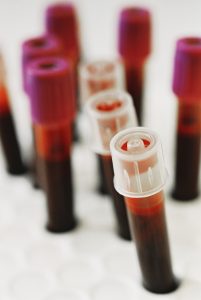![]()
 Written by: Andy An, MD/PhD Candidate, Hancock Lab (left)
Written by: Andy An, MD/PhD Candidate, Hancock Lab (left)
Edited by: Nancy Yang, MSc Candidate, Côté Lab (right)

Vacutainer tubes filled with blood. Image courtesy of the UBC Centre for Blood Research (CBR).
Imagine a cut on your hand gets infected. It gets hot, swollen, painful – but it means your immune system is fighting off that infection. Now imagine that happening throughout your entire body because the infection spread everywhere through your bloodstream. Instead of being protective, your immune system goes into overdrive, resulting in fever, low blood pressure, and life-threatening organ damage.
What I described is sepsis, a dysregulated immune response to a systemic infection that results in organ failure. In 2017, ~100,000 Canadians developed sepsis, of which ~16,000 died, and sepsis was involved in 1 in every 5 deaths worldwide1.
Up to now, sepsis research has mainly focused on how to diagnose sepsis earlier and more accurately, or better treatments to improve hospitalization outcomes. However, the long-term effects of sepsis are still poorly understood. Half of all survivors will have long-term consequences, collectively known as “post-sepsis syndrome” (PSS): a constellation of symptoms affecting the brain, muscles, heart, kidneys, lungs, and immune system2. These patients suffer from poorer quality of life and frequent rehospitalizations, with each hospitalization potentially being their last, as a third of survivors will pass away within a year after their sepsis hospitalization2. Furthermore, almost half of previously employed sepsis survivors do not return to work within 6 months after their hospitalization3, commonly experiencing symptoms disruptive to everyday life, such as fatigue, brain fog, and insomnia4.
In 2017, ~100,000 Canadians developed sepsis, of which ~16,000 died, and sepsis was involved in 1 in every 5 deaths worldwide.
Despite these debilitating long-term effects, PSS is still poorly understood and researched. In a recent review in EBioMedicine, the Hancock Lab and our collaborators documented the mechanisms and potential therapies of different aspects of PSS4. Central to the development of symptoms is the abnormal immune response that occurs during the onset of sepsis involving both hyperinflammation – called a “cytokine storm” – and immunosuppression. While the initial hyperinflammation can result in organ damage, immunosuppression persists for months, as evidenced by the higher risk of recurrent infections and sepsis after hospital discharge compared to survivors of other hospitalizations. This may be due to a combination of both epigenetic reprogramming of immune cells – non-mutational changes to their DNA that affect gene expression – as well as increases in immunosuppressive cells like regulatory T cells or myeloid-derived suppressor cells. The overactive immune response during sepsis can also damage the brain, resulting in delirium and causing one in five survivors to suffer from poor memory, shorter attention span, and slower mental processing.
In addition to cognitive issues, many sepsis survivors also develop anxiety, depression, and PTSD from their harrowing hospitalization experience and poorer quality of life. Lastly, sepsis survivors have an increased risk of fatal cardiovascular diseases such as stroke, heart attack, and heart failure, which may be caused by dysfunctional mitochondria and oxidative damage during sepsis. Due to such a wide variety of symptoms for PSS, a multi-disciplinary post-sepsis clinic may be able to provide personalized management affecting each sepsis survivor, as well as facilitate recruitment of survivors for observational studies and clinical trials to study PSS and potential treatments.
With a better understanding of post-sepsis syndrome, new management strategies and therapeutic interventions can be developed to make sure that sepsis survivors stay survivors.
Interestingly, the COVID-19 pandemic has brought new attention to this phenomenon, as severe COVID-19 is essentially viral sepsis and the symptoms of COVID “long-haulers” are similar to those of sepsis survivors5. This has led to heightened scientific interest into long-term COVID symptoms, with the NIH recently granting $470 million to study “long COVID”6. The results from this new body of research will hopefully also be applicable to sepsis in general, as well as raise awareness and increase research interest in PSS.
Care for sepsis should not end at hospital discharge. Many sepsis survivors describe feeling lost, scared, and uncared for after surviving their hospitalization, with their primary physicians being ill-equipped at managing their symptoms. Sepsis does not “end” at discharge – it is just the beginning of a long road to recovery for the patient. Thankfully, we are also approaching the “end” of a research period where PSS was neglected. It is the beginning of an era of heightened interest in this phenomenon, spurred by increased sepsis awareness, prevalence, patient advocacy, and the COVID-19 pandemic. With a better understanding of PSS, new management strategies and therapeutic interventions can be developed to make sure that sepsis survivors stay survivors.
This story was originally submitted, in a shorter form, to the 2020-2021 Canadian Blood Services Lay Science Writing Competition, which was organized by the Canadian Blood Services’ Centre for Innovation with support from the UBC Centre for Blood Research. The competition theme was “Challenges 2020”.
Read the Canadian Blood Services’ version of this story on the Research, Education and Discovery (R.E.D.) blog: Sepsis: The end is just the beginning
References
- Rudd, K. E. et al. Global, regional, and national sepsis incidence and mortality, 1990-2017: analysis for the Global Burden of Disease Study. Lancet 395, 200–211 (2020).
- Mostel, Z. et al. Post-sepsis syndrome – an evolving entity that afflicts survivors of sepsis. Molecular Medicine 26, 6 (2019).
- Poulsen, J. B., Møller, K., Kehlet, H. & Perner, A. Long-term physical outcome in patients with septic shock. Acta Anaesthesiol Scand 53, 724–730 (2009).
- van der Slikke, E. C., An, A. Y., Hancock, R. E. W. & Bouma, H. R. Exploring the pathophysiology of post-sepsis syndrome to identify therapeutic opportunities. EBioMedicine 61, 103044 (2020).
- Post-COVID Syndrome or Post-Sepsis Syndrome? Sepsis Alliance https://www.sepsis.org/news/post-covid-syndrome-or-post-sepsis-syndrome/.
- NIH Grants $470 Million for Study of Long COVID. The Scientist Magazine https://www.the-scientist.com/news-opinion/nih-grants-470-million-for-study-of-long-covid-69192.


